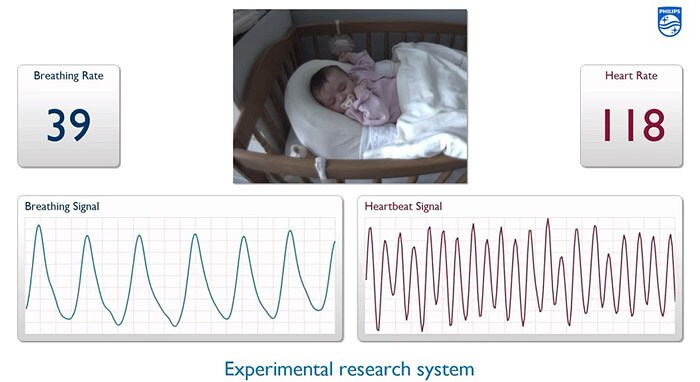Philips proprietary camera based monitoring technology is first in the world to measure absolute arterial blood oxygenation (SpO2) levels without ever touching the patient
June 6, 2016
A Contactless Alternative For specific patient populations, including premature infants in the NICU, a contactless alternative would provide potential advantages such as avoiding skin damage in fragile patients and freedom to select a more physiologically central location with a possible faster response rate [1,2]. With every heartbeat, the cardiovascular pressure wave causes tiny ‘micro-blushes’ (small changes in skin color) in the face. While these changes are not visible to the human eye, Philips’ contactless monitoring algorithms can calculate an accurate pulse rate by quantifying these changes. Over the past 10 years, an increasing number of papers [3] have published on the topic of contactless monitoring in the measurement of pulse or respiration rate; however, only a handful have explored SpO2 [4] and this is the first study that has been able to convincingly demonstrate that calibrated contactless monitoring of absolute blood oxygen levels is possible. In this recent study, calibration of contactless, camera-based pulse oximetry was performed on a population of 41 healthy adults and the results are promising for the successful use of contactless monitoring for absolute blood oxygen levels in care settings without individual adjustments. [2] Cooke J, Scharf J. Improving pulse oximeter performance. Anesthesiology 2002;96:A593. [3] Sun Y, Thakor N. Photoplethysmography revisited: from contact to noncontact, from point to imaging. IEEE Transactions on Biomedical Engineering 2015; Epub ahead of print. [4] Wieringa FP, Mastik F, van der Steen AF. Contactless Multiple Wavelength Photoplethysmographic Imaging: A First Step Toward “SpO2 Camera” Technology. Annals of Biomedical Engineering 2005; 33:1034-1041.
Amsterdam, the Netherlands – Royal Philips (NYSE: PHG AEX: PHIA) today announced the results of the first published study to demonstrate that absolute oxygen saturation of arterial blood (SpO2), a vital sign that is commonly monitored in hospitalized and other patients, can be accurately measured across multiple patients using contactless technology. The study, published in the June issue of the journal Anesthesia & Analgesia, used Philips proprietary camera-based monitoring technology to measure the light reflected off the foreheads of 41 healthy adults to calculate SpO2. Through the results of this study, Philips, a global leader in patient care and monitoring solutions, is the first to demonstrate that contactless SpO2 can be calibrated across patients, just like conventional contact probes, allowing accurate measurements without individual adjustments.
In many care settings, monitoring heart rate, arterial blood oxygenation, respiration rate, and activity is a standard part of patient care to detect complications or deterioration. The current method for measuring these key vital signs requires the use of sensors on the skin or devices strapped to the body; however, these contact sensors may cause damage and distress in patients with fragile skin such as newborn babies.
“Vital signs monitoring is crucial across all types of care settings, but for patient populations with specific conditions, managing their care in a less intrusive way is critical in order to avoid unnecessary distress,” said Carla Kriwet, CEO of Philips Patient Care & Monitoring Solutions. “Contactless monitoring solutions will offer clinicians with a way to accurately measure vital signs for patients in a non-obtrusive way, and provide them with the data needed to know when to intervene.”
This study is the latest from Philips in its longstanding leadership in the area of contactless monitoring. In addition to the successful results of this study, Philips’ contactless monitoring solutions show promise for accurately measuring key vital signs such as heart rate and respiration rate. Philips is well-positioned to leverage its expertise and leadership in patient monitoring to tailor contactless solutions for monitoring applications across the care continuum.
For more details on the full study, please click on this link.
[1] Bebout DE, Mannheimer PD. Effects of cold-induced peripheral vasoconstriction on pulse amplitude at various pulse oximeter sensor sites. Anesthesiology 2002;96:A558.
For further information, please contact:
Kathy O’Reilly Philips Group Communications Tel: +1 978-659-2638 Mobile: +1 978-221-8919 Email: kathy.oreilly@philips.com Twitter: @kathyoreilly Philips Patient Care and Monitoring Solutions Tel: +1 978-482-5949 Mobile: +1 617-599-6624
Ingrid Mitchell
About Royal Philips
Royal Philips (NYSE: PHG, AEX: PHIA) is a leading health technology company focused on improving people’s health and enabling better outcomes across the health continuum from healthy living and prevention, to diagnosis, treatment and home care. Philips leverages advanced technology and deep clinical and consumer insights to deliver integrated solutions. The company is a leader in diagnostic imaging, image-guided therapy, patient monitoring and health informatics, as well as in consumer health and home care. Headquartered in the Netherlands, Philips’ health technology portfolio generated 2015 sales of EUR 16.8 billion and employs approximately 69,000 employees with sales and services in more than 100 countries. News about Philips can be found at www.philips.com/newscenter.

